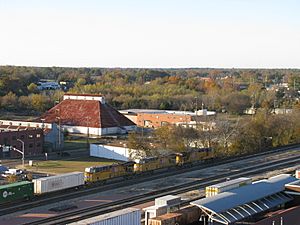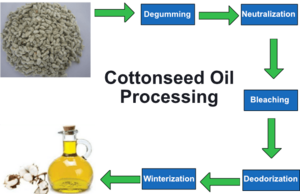Cottonseed oil facts for kids
Cottonseed oil is a cooking oil that comes from the seeds of the cotton plant. These plants are mostly grown for their cotton fiber, but their seeds are also used to make oil and animal feed. The main types of cotton plants used are Gossypium hirsutum and Gossypium herbaceum.
Cotton seeds are like other oilseeds such as sunflower seed. They have an oily inside part called a kernel, which is surrounded by a tough outer shell called a hull. When cottonseed oil is made, the oil is taken out from this kernel. Cottonseed oil is often used in things like salad oil, mayonnaise, and salad dressing. It's popular for these products because its flavor stays good for a long time.
Contents
- What is Cottonseed Oil Made Of?
- How Cottonseed Oil Looks and Tastes
- How Cottonseed Oil is Made
- History of Cottonseed Oil
- Rules for Cottonseed Oil
- How Cottonseed Oil is Taken Out of Seeds
- Making Cottonseed Oil Pure (Refining)
- How Cottonseed Oil is Used in Food
- Other Uses for Cottonseed Oil
- Cottonseed Oil as a Bug Killer
- See also
What is Cottonseed Oil Made Of?

Cottonseed oil is mostly made of unsaturated fats, about 70% of it. This includes 18% monounsaturated fats and 52% polyunsaturated fats. The other 26% are saturated fats. If the oil is made very solid (a process called hydrogenation), it becomes almost all saturated fat. The cottonseed oil industry says that their oil doesn't need as much processing as some other oils to get good results.
Cotton plants naturally produce a yellow substance called Gossypol. This substance is found in tiny glands within the seed, leaves, and roots of the cotton plant. It helps the plant protect itself from insects. When cottonseed oil is made, it goes through special steps to remove almost all of the gossypol. These steps are called refining, bleaching, and deodorizing. Sometimes, a chemical called ferric chloride is used to remove the color from the oil.
How Cottonseed Oil Compares to Other Oils
Cottonseed oil has a unique mix of fats compared to other common cooking oils. This mix affects how it can be used in cooking and how healthy it is.
How Cottonseed Oil Looks and Tastes
Once cottonseed oil is processed, it has a mild taste. It usually looks clear and has a light golden color. The amount of color depends on how much it has been refined. It can be used for frying because it has a high smoke point, which means it can get very hot before it starts to smoke.
Cottonseed oil is also rich in tocopherols, which are like Vitamin E. These help the oil stay fresh for a long time. This is why food makers often use it in packaged foods, as it helps these products last longer on the shelf.
How Cottonseed Oil is Made
In 2019, the world produced about 4.45 million tonnes of cottonseed oil. The top countries producing it were China and India, making more than half of the total amount together.
| Country | Millions of tonnes |
|---|---|
| 1.28 | |
| 1.20 | |
| 0.32 | |
| 0.28 | |
| 0.22 | |
| 0.21 | |
| World | 4.45 |
History of Cottonseed Oil
For a long time, before the late 1800s, cottonseed was thought to be almost useless. Even as cotton production grew, most of the seeds were just left to rot or thrown away. Some were used for planting, fertilizer, or animal feed, but that was a small amount.
In the 1820s and 1830s, Europe needed more fats and oils because its population was growing fast. This made prices for fats and oils go up a lot. Many people in the United States tried to make oil from cottonseed to sell to Europe. But it was hard to separate the outer hull from the inner kernel.
This problem was solved in 1857 when William Fee invented a machine called a huller. This machine could easily separate the tough hulls from the cottonseed kernels. After this invention, cottonseed oil started to be used in lamps for light, as whale oil and lard were becoming very expensive. However, by 1859, the new petroleum industry started, and the American Civil War also affected the cotton industry, so this use for cottonseed oil ended.
Later, cottonseed oil was sometimes secretly mixed with animal fats like lard. This practice was discovered in 1884. Because of this, laws were passed that required products mixed with cottonseed oil to be labeled as "lard compound." Cottonseed oil was also mixed with olive oil. When this was found out, many countries put extra taxes on American olive oil, and Italy even banned it in 1883. These rules made cottonseed oil sales go down, leading to too much oil and lower prices.
Because cottonseed oil was so cheap, a new company called Procter & Gamble decided to use it. They were looking for a cheaper replacement for expensive animal fats in their soap and candle businesses. They found a way to make cottonseed oil solid through a process called hydrogenation. This new product looked a lot like lard.
In 1911, Procter & Gamble started a big advertising campaign for their new product, Crisco. Crisco was a vegetable shortening that could be used instead of lard. They advertised it as being "easier on digestion" and "healthier." They even gave away free cookbooks that only had recipes using Crisco. By the 1920s, Crisco became very popular. Another company, David Wesson, also developed a popular product called Wesson cooking oil in 1899.
For the next 30 years, cottonseed oil became the most common cooking oil in the United States. Crisco and Wesson oil were used for baking, frying, and in salad dressings. During World War Two, there wasn't enough cottonseed oil, so people started using soybean oil instead. By 1944, more soybean oil was made than cottonseed oil, and it was cheaper. By the 1950s, soybean oil had largely replaced cottonseed oil in products like Crisco. The amount of land used for cotton also decreased as farmers started growing more corn and soybeans.
In the 2000s, people started trying to avoid trans fats in their food. Cottonseed oil was then changed so it had very little to no trans fats. This led to more people using it, and some health experts even suggested it as a healthy oil. However, some still argue that cottonseed oil's high amount of polyunsaturated fats and how it's processed might not make it the healthiest choice.
Rules for Cottonseed Oil
In Canada, cottonseed oil must come from the seeds of the Gossypium plant. If a product is 100% cottonseed oil, its label must clearly say "cottonseed oil."
Cottonseed oil sold for eating must be processed and refined. This is to remove certain parts, like gossypol, which can be harmful to people.
How Cottonseed Oil is Taken Out of Seeds
Cottonseed oil, like other vegetable oils, is taken from the plant's seeds. This can be done in a few ways:
- Mechanical ways: Crushing or pressing the seeds.
- Chemical ways: Using special liquids (solvents) to pull out the oil.
Most cottonseed oil is taken out using the chemical solvent method.
Making Cottonseed Oil Pure (Refining)
Plant oils are made of fatty acids. Once the raw oil is taken out, it needs to be cleaned and made pure before people can eat it. This process removes things like extra fatty acids, pigments (colors), and other unwanted parts.
Degumming
The first step in cleaning the oil is called degumming. This removes things like phospholipids, gums, and waxes from the raw oil. Water or weak acids are added to the oil. This makes the unwanted parts stick together and form "gums." These gums don't mix with the oil and are then separated using special machines called centrifuges. The separated gums can then be used to make things like lecithin, which helps mix oil and water.
Neutralization
The second step is to remove extra fatty acids from the oil. This is done by adding a substance called caustic soda (sodium hydroxide). Cottonseed oil goes through three stages of this cleaning process to make it very pure.
In the first stage, caustic soda is added to the oil. This helps remove some of the extra fatty acids. These fatty acids react with the caustic soda to form "soap." This "soap" is then separated from the oil.
Sometimes, some of the good oils can also be affected. So, a second stage repeats the process with more caustic soda. The final stage is a second wash with water to make sure almost no "soap" is left in the oil.
Bleaching
The third step is bleaching. This removes any leftover soap, gums, or colors from the oil. A special type of clay called bleaching earth is often used. This clay sticks to the unwanted parts in the oil. Then, the mixture is filtered to remove the clay and all the things it has collected.
Deodorization
The fourth step is called deodorization. This removes any smells or tastes that are not wanted in the oil. High-pressure steam is used to distill these unwanted substances out of the oil.
Winterization
The fifth step is winterization. This is done to remove certain fats that can make the oil cloudy or solid at cool temperatures. The oil is stored in a cool place, below 5 degrees Celsius (41 degrees Fahrenheit).
At this cool temperature, the unwanted fats become solid and form crystals. The oil then separates into a liquid part and a solid part. These two parts are then separated by filtering.
How Cottonseed Oil is Used in Food
Cottonseed oil has been used in many foods, like potato chips. For many years, it was a main ingredient in Crisco, a popular shortening product. Today, Crisco is mostly made from soybean oil and palm oil. Cottonseed oil is often cheaper than olive oil or canola oil, so it's a popular choice for restaurants and snack food companies for frying.
Cottonseed oil is also used to make other edible products like cooking oils, salad oils, margarines, and shortenings. In the United States, it's used in products like Olestra, which are non-digestible fat substitutes that help make fried foods creamy and rich.
Other Uses for Cottonseed Oil
Cottonseed oil is also used outside of food. In farming, it can be a strong insecticide (bug killer). It's often used for tough pest problems on fruit trees. It can also be mixed with other bug killers to fight more types of pests. Spider mites, whiteflies, and young scales are common pests that cottonseed oil can help control.
Cottonseed Oil as a Bug Killer
The natural properties of untreated cottonseed oil can be helpful in farming. Oils, including vegetable oils, have been used for hundreds of years to control insect and mite pests. More recently, cottonseed oil has been used to protect the trunks of apple trees from the apple clearwing moth. This moth burrows into the tree's bark and can harm or even kill the tree. Cottonseed oil is generally thought to be one of the most effective vegetable oils for killing insects.
See also
 In Spanish: Aceite de algodón para niños
In Spanish: Aceite de algodón para niños




